steering FIAT DOBLO 2009 2.G User Guide
[x] Cancel search | Manufacturer: FIAT, Model Year: 2009, Model line: DOBLO, Model: FIAT DOBLO 2009 2.GPages: 274, PDF Size: 6.6 MB
Page 157 of 274
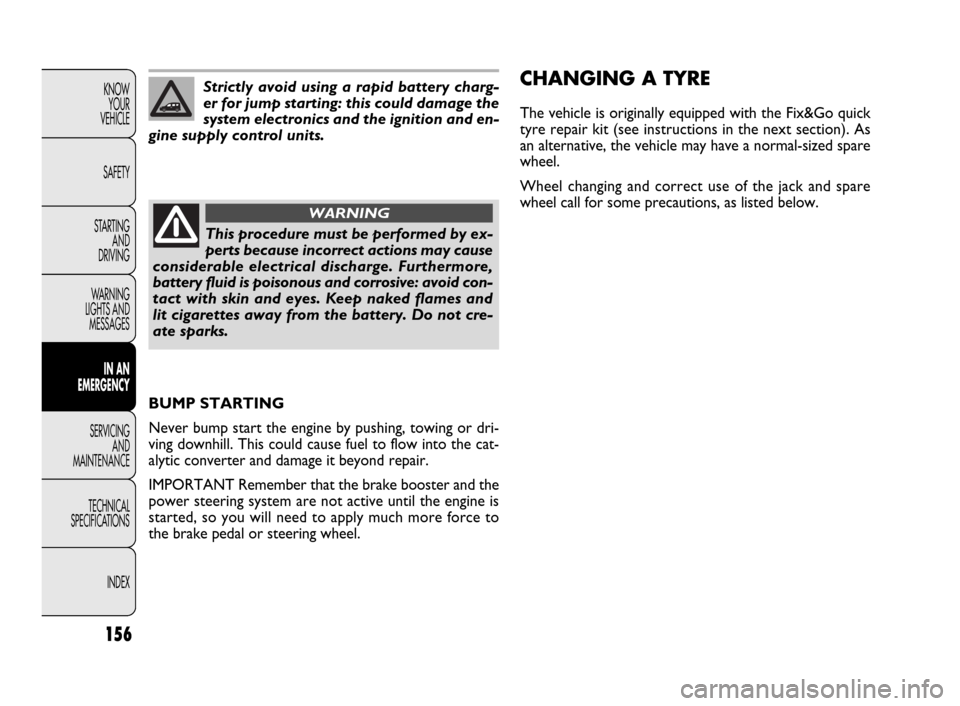
156
KNOW
YOUR
VEHICLE
SAFETY
STARTING
AND
DRIVING
WARNING
LIGHTS AND
MESSAGES
IN AN
EMERGENCY
SERVICING
AND
MAINTENANCE
TECHNICAL
SPECIFICATIONS
INDEXStrictly avoid using a rapid battery charg-
er for jump starting: this could damage the
system electronics and the ignition and en-
gine supply control units.
This procedure must be performed by ex-
perts because incorrect actions may cause
considerable electrical discharge. Furthermore,
battery fluid is poisonous and corrosive: avoid con-
tact with skin and eyes. Keep naked flames and
lit cigarettes away from the battery. Do not cre-
ate sparks.
WARNING
BUMP STARTING
Never bump start the engine by pushing, towing or dri-
ving downhill. This could cause fuel to flow into the cat-
alytic converter and damage it beyond repair.
IMPORTANT Remember that the brake booster and the
power steering system are not active until the engine is
started, so you will need to apply much more force to
the brake pedal or steering wheel.
CHANGING A TYRE
The vehicle is originally equipped with the Fix&Go quick
tyre repair kit (see instructions in the next section). As
an alternative, the vehicle may have a normal-sized spare
wheel.
Wheel changing and correct use of the jack and spare
wheel call for some precautions, as listed below.
Page 185 of 274
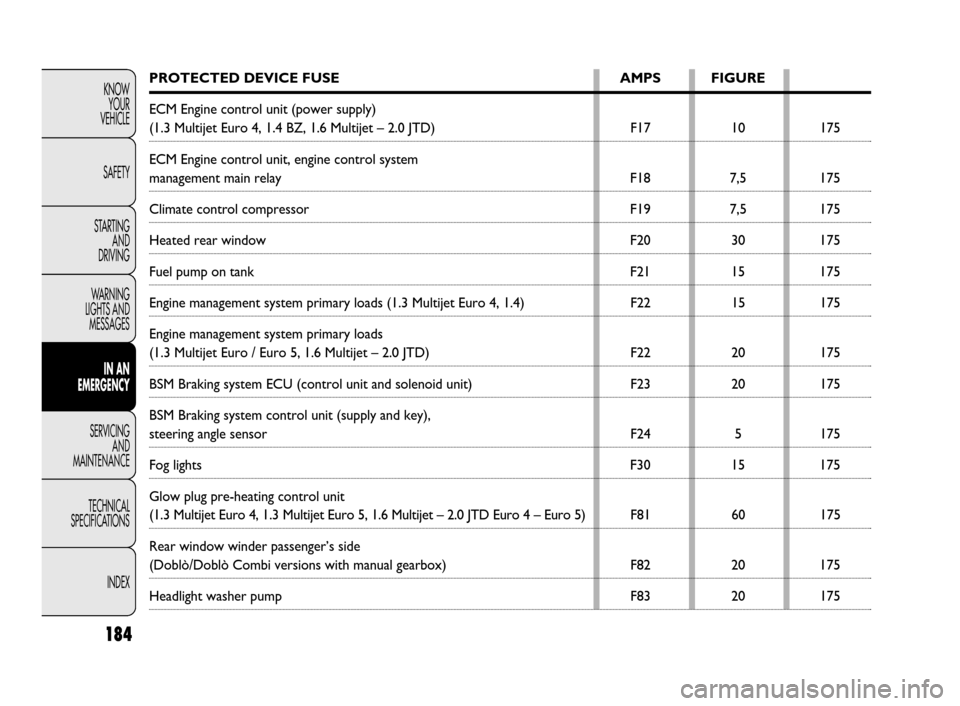
184
KNOW
YOUR
VEHICLE
SAFETY
STARTING
AND
DRIVING
WARNING
LIGHTS AND
MESSAGES
IN AN
EMERGENCY
SERVICING
AND
MAINTENANCE
TECHNICAL
SPECIFICATIONS
INDEXPROTECTED DEVICE FUSE AMPS FIGURE
ECM Engine control unit (power supply)
(1.3 Multijet Euro 4, 1.4 BZ, 1.6 Multijet – 2.0 JTD) F17 10 175
ECM Engine control unit, engine control system
management main relay F18 7,5 175
Climate control compressor F19 7,5 175
Heated rear window F20 30 175
Fuel pump on tank F21 15 175
Engine management system primary loads (1.3 Multijet Euro 4, 1.4) F22 15 175
Engine management system primary loads
(1.3 Multijet Euro / Euro 5, 1.6 Multijet – 2.0 JTD) F22 20 175
BSM Braking system ECU (control unit and solenoid unit) F23 20 175
BSM Braking system control unit (supply and key),
steering angle sensor F24 5 175
Fog lights F30 15 175
Glow plug pre-heating control unit
(1.3 Multijet Euro 4, 1.3 Multijet Euro 5, 1.6 Multijet – 2.0 JTD Euro 4 – Euro 5) F81 60 175
Rear window winder passenger’s side
(Doblò/Doblò Combi versions with manual gearbox) F82 20 175
Headlight washer pump F83 20 175
Page 191 of 274

190
KNOW
YOUR
VEHICLE
SAFETY
STARTING
AND
DRIVING
WARNING
LIGHTS AND
MESSAGES
IN AN
EMERGENCY
SERVICING
AND
MAINTENANCE
TECHNICAL
SPECIFICATIONS
INDEX
F0V0051mfig. 179
Before towing, turn the ignition key to
MAR and then to STOP without extract-
ing it. The steering column will automatically lock
when the key is removed, making it impossible to
turn the wheels.
WARNING
Before tightening the ring, clean the
threaded housing thoroughly. Before tow-
ing the vehicle, make sure that the tow ring is ful-
ly tightened in its appropriate housing.
Never start the engine when the vehicle is being
towed.
WARNING
Remember that, while being towed, you
will need to brake harder because there
will be no assistance from the brake booster. Do
not use bendy cables for towing and avoid jerk-
ing. During towing operations, make sure that the
fastened joint does not damage adjoining com-
ponents. When towing the vehicle, comply with
the specific rules of the highway code regarding
the towing device and road conduct. Do not start
the engine while being towed.
WARNING
The front and rear tow hooks should be
used only for emergencies on the road. You
are allowed to tow the car for short dis-
tances using an appropriate device in accordance
with the highway code (a rigid bar), to move the
vehicle on the road in readiness for towing or trans-
porting via a breakdown vehicle. Tow hooks MUST
NOT be used to tow vehicles off the road or where
there are obstacles and/or for towing operations
using cables or other non-rigid devices. Respecting
the above conditions, towing must take place with
two vehicles (one towing, the other towed) aligned
as much as possible along the same centre line.
Page 200 of 274

199
KNOW
YOUR
VEHICLE
SAFETY
STARTING
AND
DRIVING
WARNING
LIGHTS AND
MESSAGES
IN AN
EMERGENCY
SERVICING
AND
MAINTENANCE
TECHNICAL
SPECIFICATIONS
INDEX
fig. 180 – 1.4 versions
fig. 181 – 1.3 Multijet versions without DPFF0V0076m
F0V0187m
CHECKING LEVELS
A. Engine oil filler
B. Engine oil dipstick
C. Engine coolant
D. Windscreen washer fluid
E. Brake fluid
F. Battery
G. Power steering fluid
Never smoke while
working in the engine
compartment: flammable gases
and vapours may be present.
Fire hazard.
WARNING
When topping up, be
careful not to confuse the
various types of fluids:
they are all mutually incompati-
ble and may severely damage
your vehicle.
Page 201 of 274
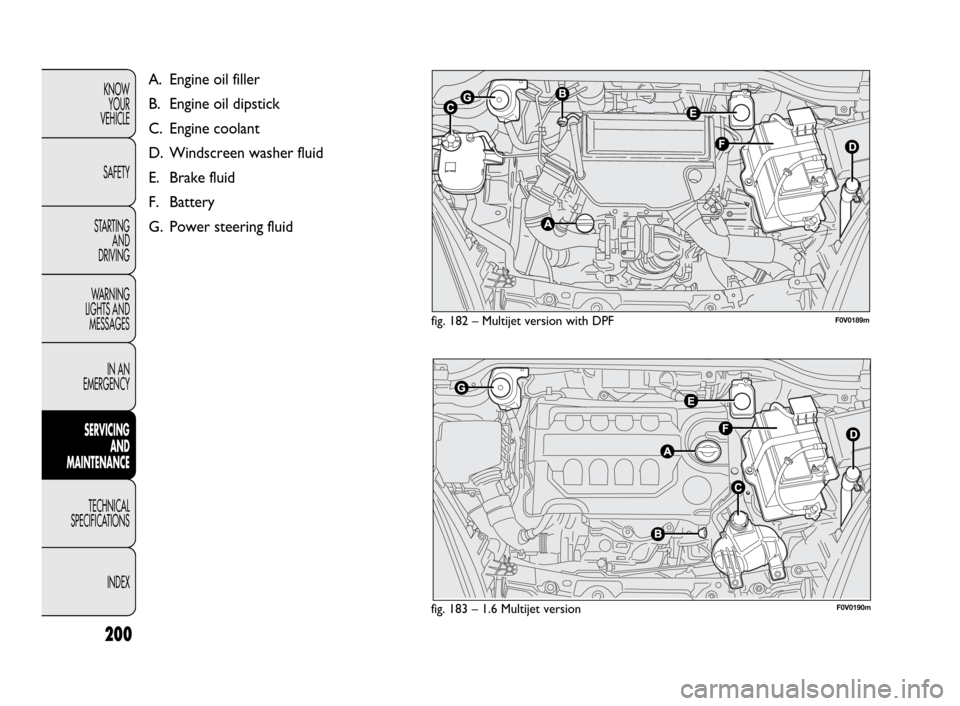
200
KNOW
YOUR
VEHICLE
SAFETY
STARTING
AND
DRIVING
WARNING
LIGHTS AND
MESSAGES
IN AN
EMERGENCY
SERVICING
AND
MAINTENANCE
TECHNICAL
SPECIFICATIONS
INDEX
fig. 182 – Multijet version with DPF
fig. 183 – 1.6 Multijet versionF0V0189m
F0V0190m
A. Engine oil filler
B. Engine oil dipstick
C. Engine coolant
D. Windscreen washer fluid
E. Brake fluid
F. Battery
G. Power steering fluid
Page 202 of 274
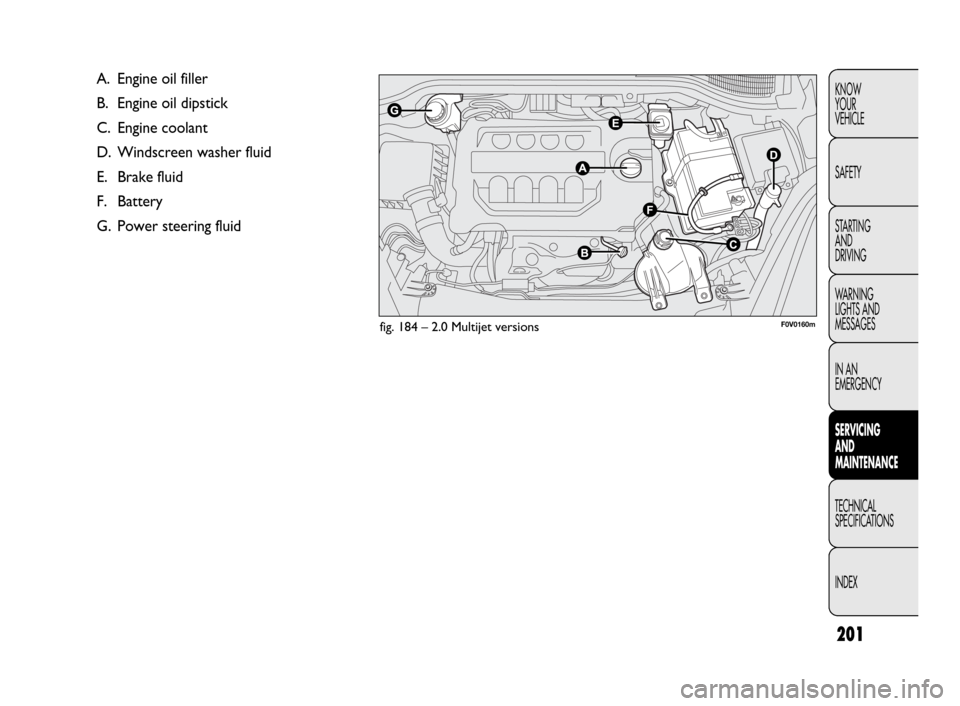
201
KNOW
YOUR
VEHICLE
SAFETY
STARTING
AND
DRIVING
WARNING
LIGHTS AND
MESSAGES
IN AN
EMERGENCY
SERVICING
AND
MAINTENANCE
TECHNICAL
SPECIFICATIONS
INDEX
fig. 184 – 2.0 Multijet versions
A. Engine oil filler
B. Engine oil dipstick
C. Engine coolant
D. Windscreen washer fluid
E. Brake fluid
F. Battery
G. Power steering fluid
F0V0160m
Page 206 of 274

205
KNOW
YOUR
VEHICLE
SAFETY
STARTING
AND
DRIVING
WARNING
LIGHTS AND
MESSAGES
IN AN
EMERGENCY
SERVICING
AND
MAINTENANCE
TECHNICAL
SPECIFICATIONS
INDEXPOWER STEERING FLUID
fig. 180-181-182-183-184
Check that oil level with the vehicle on flat ground and
engine cold is included between the MIN and MAX ref-
erences on the reservoir body.
The level may go over the MAX line when the oil is hot.
If topping up is required, make sure the oil you use has
the same specifications as that already in the system.Power steering fluid consumption is very
low. If the fluid needs topping up a short
time after the last top-up, have the system
checked by a Fiat Dealership to ensure there are
no leaks.
Do not push the power steering all the way
for longer than eight seconds with the en-
gine running because it will cause noise and
risk damaging the system.
Because it is flammable, do not allow the
power steering fluid to come into contact
with hot parts of the engine.
WARNING
Page 210 of 274
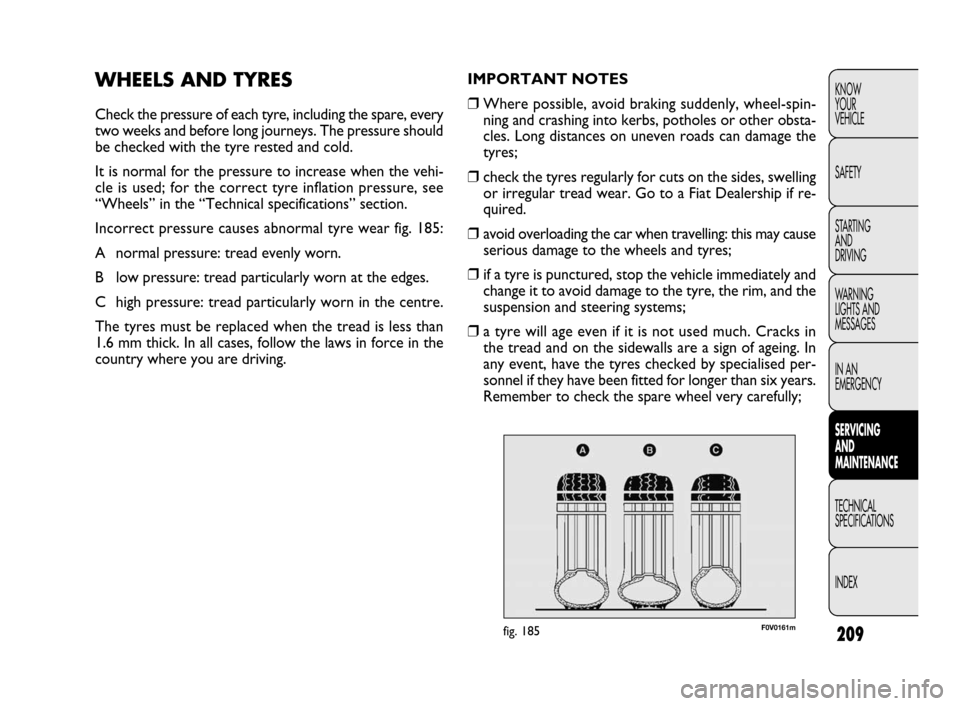
209
KNOW
YOUR
VEHICLE
SAFETY
STARTING
AND
DRIVING
WARNING
LIGHTS AND
MESSAGES
IN AN
EMERGENCY
SERVICING
AND
MAINTENANCE
TECHNICAL
SPECIFICATIONS
INDEXIMPORTANT NOTES
❒Where possible, avoid braking suddenly, wheel-spin-
ning and crashing into kerbs, potholes or other obsta-
cles. Long distances on uneven roads can damage the
tyres;
❒check the tyres regularly for cuts on the sides, swelling
or irregular tread wear. Go to a Fiat Dealership if re-
quired.
❒avoid overloading the car when travelling: this may cause
serious damage to the wheels and tyres;
❒if a tyre is punctured, stop the vehicle immediately and
change it to avoid damage to the tyre, the rim, and the
suspension and steering systems;
❒a tyre will age even if it is not used much. Cracks in
the tread and on the sidewalls are a sign of ageing. In
any event, have the tyres checked by specialised per-
sonnel if they have been fitted for longer than six years.
Remember to check the spare wheel very carefully;WHEELS AND TYRES
Check the pressure of each tyre, including the spare, every
two weeks and before long journeys. The pressure should
be checked with the tyre rested and cold.
It is normal for the pressure to increase when the vehi-
cle is used; for the correct tyre inflation pressure, see
“Wheels” in the “Technical specifications” section.
Incorrect pressure causes abnormal tyre wear fig. 185:
A normal pressure: tread evenly worn.
B low pressure: tread particularly worn at the edges.
C high pressure: tread particularly worn in the centre.
The tyres must be replaced when the tread is less than
1.6 mm thick. In all cases, follow the laws in force in the
country where you are driving.
F0V0161mfig. 185
Page 218 of 274

217
KNOW
YOUR
VEHICLE
SAFETY
STARTING
AND
DRIVING
WARNING
LIGHTS AND
MESSAGES
IN AN
EMERGENCY
SERVICING
AND
MAINTENANCE
TECHNICAL
SPECIFICATIONS
INDEXLEATHER UPHOLSTERED STEERING
WHEEL/GEAR KNOB/HANDBRAKE LEVER
(for versions/market, where provided)
These components must be cleaned with mild soap and
water only. Never use spirits or alcohol-based products.
Read the product label carefully before using specific prod-
ucts for cleaning the interiors: make sure the product does
not contain spirits or alcohol-based substances.
If, when cleaning the windscreen with special products,
window cleaner accidentally drips onto the leather of the
steering wheel/gear lever knob/hand brake, wipe away im-
mediately and then wash the affected area with mild soap
and water.
IMPORTANT Be careful when installing a steering wheel
locking device not to damage the leather upholstery. SEATS AND FABRIC PARTS
Remove dust with a soft brush or a vacuum cleaner. It is
advisable to use a damp brush on velvet upholstery.
Rub the seats with a sponge and a solution of water and
mild soap.
PLASTIC PARTS
It is advisable to clean interior plastic parts with a damp
cloth and a solution of water and non-abrasive mild soap.
To remove grease and tough stains, use products designed
specifically for cleaning plastics. These have no solvents
and have been designed so that they do not alter the ap-
pearance and colour of the components.
IMPORTANT Never use spirits or petroleum to clean
the instrument panel glass.
Page 222 of 274
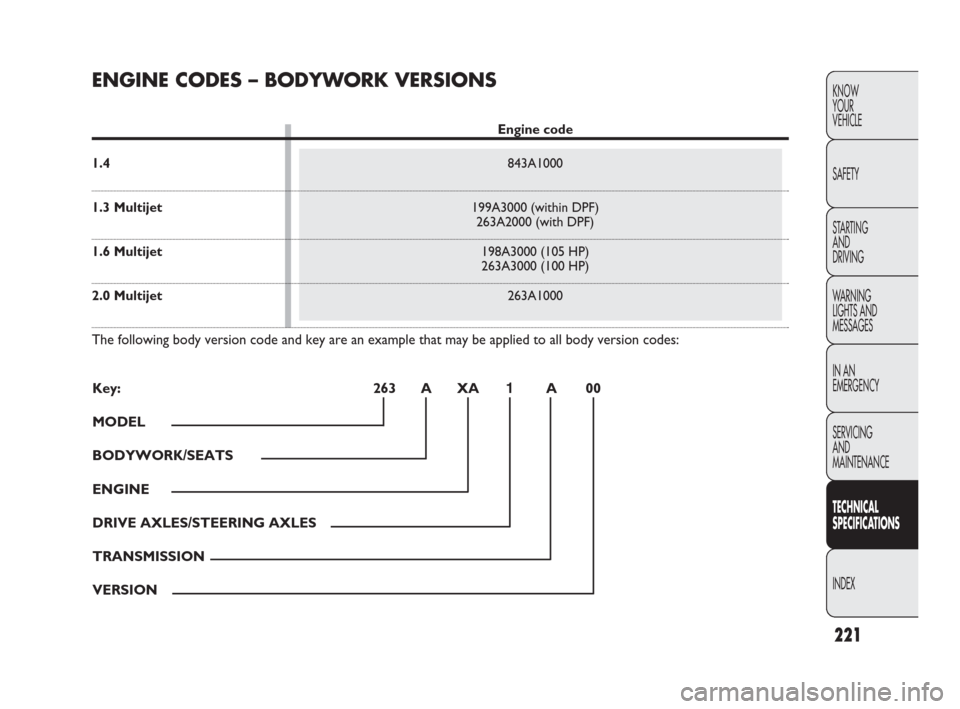
221
KNOW
YOUR
VEHICLE
SAFETY
STARTING
AND
DRIVING
WARNING
LIGHTS AND
MESSAGES
IN AN
EMERGENCY
SERVICING
AND
MAINTENANCE
TECHNICAL
SPECIFICATIONS
INDEX
ENGINE CODES – BODYWORK VERSIONS
Engine code
1.4843A1000
1.3 Multijet199A3000 (within DPF)263A2000 (with DPF)
1.6 Multijet198A3000 (105 HP)
263A3000 (100 HP)
2.0 Multijet263A1000
The following body version code and key are an example that may be applied to all body version codes:
Key: 263 A XA1A00
MODEL
BODYWORK/SEATS
ENGINE
DRIVE AXLES/STEERING AXLES
TRANSMISSION
VERSION